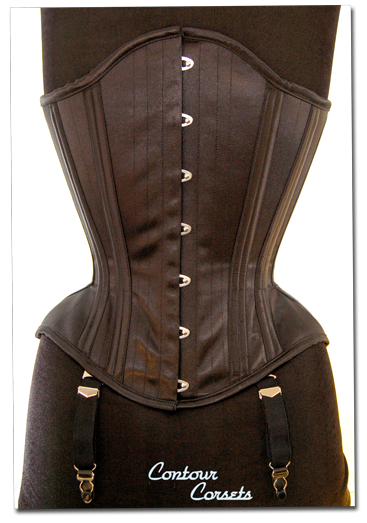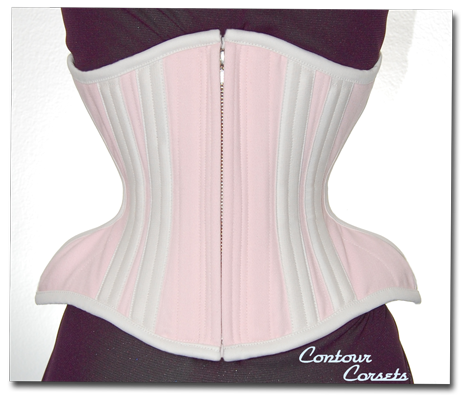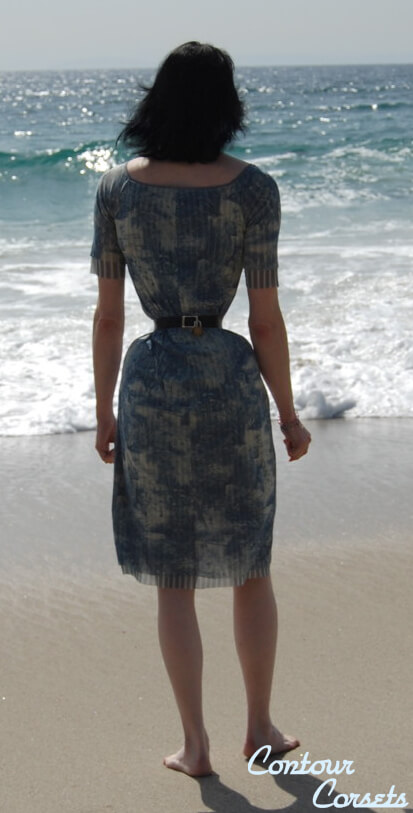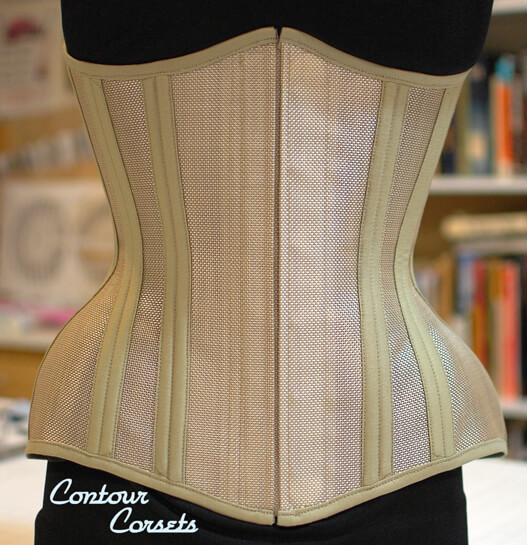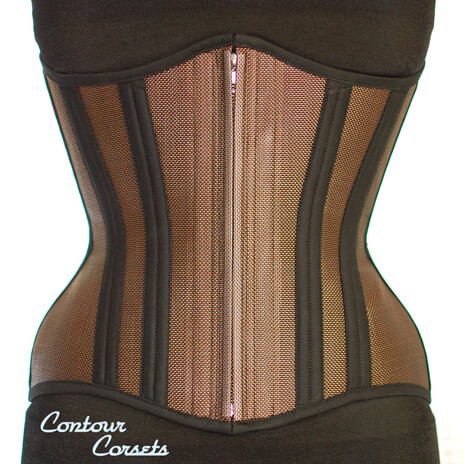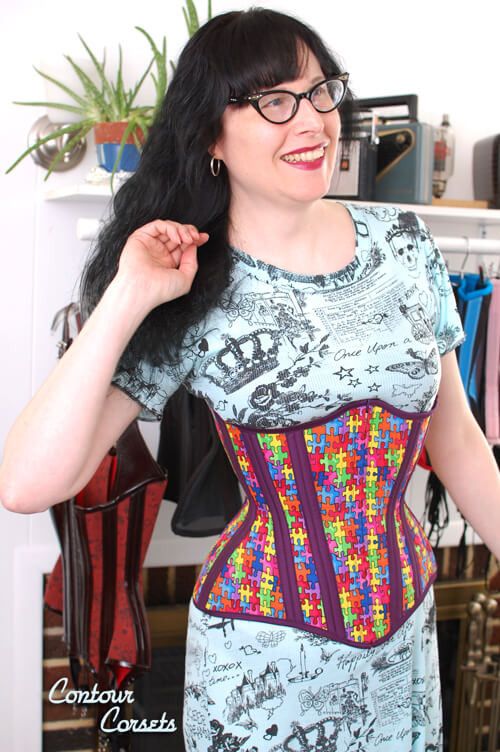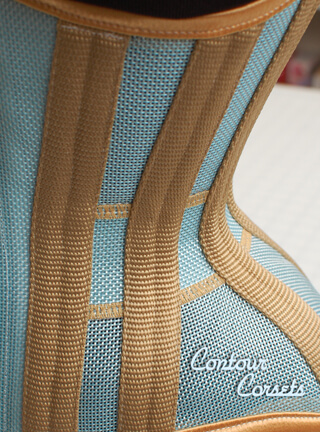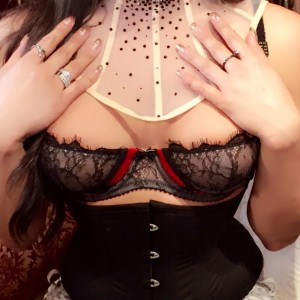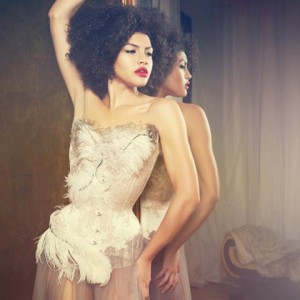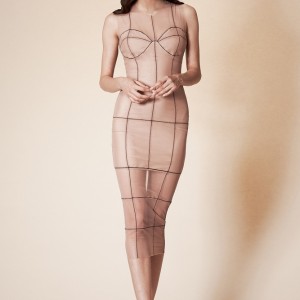Indie Corsetiere Spotlight: An Interview with Contour Corsets' Fran Blanche
Editor's Note: As of April 2017, it appears Contour Corsets is no longer operational.
Launched in 2008, Contour Corsets by Fran Blanche specializes in the creation of expertly fitted tightlacing corsets. We featured her on The Lingerie Addict a few weeks ago while discussing Corset Shopping for Trans Women. Fran's approach to corsetmaking relies on utilizing modern materials and the application of her engineering background to build anatomically precise corsets suitable for all-day tightlacing wear. I'm very pleased to publish this interview --- each of Fran's responses is so thoughtful and eloquent.
How does the name Contour Corsets reflect the elements that make your brand unique?
The Contour name was an attempt to build a brand that was direct and forthright about the nature of the product. So rather than having it be about me or any kind of cultural imagery, I wanted the work to speak for itself.
How long have you been making corsets? What led you down the corsetmaking path?
I have loved corsets my whole adult life. I made several pieces in my twenties which were, honestly, not very good, but they did work. I also wore off-the-rack corsets fashionably for many years as occasional outerwear. However, my intense interest in tightlacing came out of my partnership with Amy Crowder. She made many corsets for me over the years, and her philosophies were the basis for my own tightlacing regimen and corset designs. I developed special tooling and production processes for her company, Wasp Creations.
The reasons for designing and constructing corsets for myself was really just out of necessity. I had various specific problems with the fit of my corsets at that time because of my asymmetrical shape. I also needed to replace my daily wear corsets regularly. I started making real functional corsets for myself and friends in 2008, and creating them full time professionally for others after 2010. Over time, I honed my skills in anatomical patterning. I simultaneously developed construction techniques which cast off traditions in favor of improved and more modern methods and materials. The result was an ever-evolving design philosophy that has spawned my line of unique, anatomically-fitted corsets.
Do you also make other garments or accessories?
I used to, but demands on my time these days for tightlacing designs have narrowed my work to specialize in daily wear corsets.
What defines the Contour Corsets ideal of fit and silhouette?
I have no real defining shapes per se, because my designs are anatomical. Anatomical variations in every individual make each project unique. The goal is to achieve support and shaping with comfort by taking into account the real anatomy and structure of the wearer. Using these guides I try to create a garment which will sculpt that natural shape to a new form in a healthy way, rather than trying to apply the edicts of fashion or style on the body. This is the underlying core of my design philosophy.
It seems you are best known for tightlacing, medical, and feminizing corsetry. Is that by intent or happenstance? What do you think these niches-within-a-niche have in common?
I cater to everyone, and the array of work represents the spectrum of the community. People of all genders and social strata come to me for designs, and every customer has their own needs and goals. It is a big part of my job to sort through the requirements and expectations of each person and build a project around their needs. Every day is a new challenge.
Is there anything in particular that is different about making corsets for trans women?
Not really. Anatomical variations are the norm throughout our species, and there are no standards or templates for body and gender. Everyone is unique, and every shape is unique --- I have never made any two corsets alike. Every client who is interested in shaping has goals where they wish to alter aspects of their body, and therein lies the universal desire which brings people into the tightlacing community.
Do you find that the psychological side of wearing a corset (its societal weight as femme garb, the ritual of lacing, the sensation of wearing armor, and/or deep pressure therapy) helps to make it a tool beyond its inherent physical feminization?
I suppose it would all depend on how one defines femininity: that is, whether it is a strength or a weakness. I have always regarded the corset as an empowering device: a vehicle for self control and promoting the will of the mind over the body. It takes strength and ambition to tightlace, and a great deal of courage to flaunt the shape of the corset in the face of society's conventions, fighting the stigmas and misconceptions, and facing the entrenched opinions of others. But the reasons for wearing a corset are as varied as the people. There are some who simply require support and have no specific fetish about the corset or what it represents, and for others the practice of tightlacing and its rituals have deep personal meaning and significance. Some see it as a feminine garment, some see it as fantasy, yet others consider it to be nothing of the sort --- it really depends on the perspective of the wearer.
Is there another facet of corsetry you'd like to indulge in more frequently?
I think I've done it all! Personally, I have to work far too much to really enjoy any of it for myself these days.
It's pretty unusual that you use a zipper as your standard closure. Why is that? Do you ever build corsets with a busk?
I do, and some clients prefer a steel button busk, but wherever possible I believe in using all of the best modern components in my designs.
Tell us a bit about your process for working with clients remotely. You don't have any standard-size patterns, correct? About how many measurements do you utilize for a basic underbust? What's your policy regarding mockups?
No standard patterns --- I draft each by hand on paper from scratch for every piece. So, very rarely do I make a mockup or test corset. I almost always go right to the finished product. The only exceptions are with some very expensive leather items which may have a complicated remote fit. The process of remote fittings boils down to good communication, and the client understanding what it is that I need. My online guide is pretty detailed, but many people still need additional guidance through the measuring process. That kind of correspondence constitutes a significant allotment of my attention every week. I also developed a process of extrapolating better pattern compliance through scaled photographs that clients can create using a special photo guide, to be sent along with their measurements.
Are there any design details or styling that you or your clients think of as signature to Contour Corsets?
I could not say, but my work does have a certain 'look.'
Where did you learn to make corsets? Are there any particular resources you would recommend to burgeoning corsetieres?
Learning by failing is the only way to gain real knowledge, and if you can struggle to be sure that you never make the same mistake twice then each failure makes you better at what you do. Put in lots of time, trial, and error over years --- and after a while you can get really damn good at something.
What is your favorite part of the process? Do you have a favorite piece of equipment in your studio?
I could definitely tell you what I like least about the process! There is a lot of labor and drudgery in producing any product to a high bar of expectations, and a lot of stress that goes along with it. The process of creating anything good is always somewhat painful. The reward is the satisfaction of the customer, and I always appreciate the gratitude and loyalty of my customers. As for the studio equipment, I use several industrial sewing machines, and I have many specialty tools that I have developed and built which are essential to my production methods and have become indispensable to me, among these are the rotary bench punch and pedal operated grommet press.
Do you have any particular clients you would consider a muse?
I play no favorites but there are several clients who have really rallied the public to my work in many ways over the years.
What are your other hobbies? Do you find they lead back into corsetmaking?
I am probably more well-known as an engineer and effects designer than I am for corset design. There is really no overlap to some of my other lifetime pursuits such as music, or bike riding, but I definitely put a great deal of engineering into my corset work. My skills as a coder, graphic designer, and photographer have allowed me to create the website and many other necessary aspects of the business of Contour Corsets. I also love riding my Shadow motorcycle, but the posture needed to ride a cruiser is not so conducive to wearing a corset....
What from your body of work are you most proud of?
There have been many challenging projects, and some really big projects, but honestly the hardest ones to do are probably the most inconspicuous. It is really about troubling over a design to get it right. The most challenging fits can seem imperceptible, and solving hard construction problems that disappear into the interior layers of a design are invisible. But after all of the work is put in, and it fits and functions just as expected, then I consider that to be another feather in my cap.
How often do you wear corsets? What benefits do you derive from wearing them?
I have derived a great deal of comfort and pride from tightlacing over my adult life. I have a few unbreakable rules for the practice, which are: Listen to your body, know your limits, and only lace when you are feeling good. That is, never if you are upset, uncomfortable, sick, or stressed. I have not been able to oblige that last rule for a long time. The long work hours that are required of me really prevent me from lacing much at all these days. But if I could ever retire, and have weekends, leisure time, and comfort like most people, then I would gladly jump into it again. For now, I have to prioritize, and these days my life is all about the work... Lots and lots of work. Someday in the future maybe I'll be able to play again. Who knows!
What currently inspires you? Do you have a vision for the next step for Contour Corsets?
There never was a grand plan. People needed really good corsets, and so I tried my best to make them. My work these days is driven far more by demand than inspiration, but there are those "Aha!" moments. The company has evolved over the years, and I imagine it, and my work, will continue to do so. As to what the future holds, who can say?
If you thought the above interview was interesting, I highly recommend perusing Fran's Writings and Resources on her website. They comprise a fascinating wealth of knowledge. Do you have a Contour Corset? What do you think about it? Which elements of Fran's answers above and overall corsetmaking philosophy most appeal to you? Share your opinion in the comments below!





